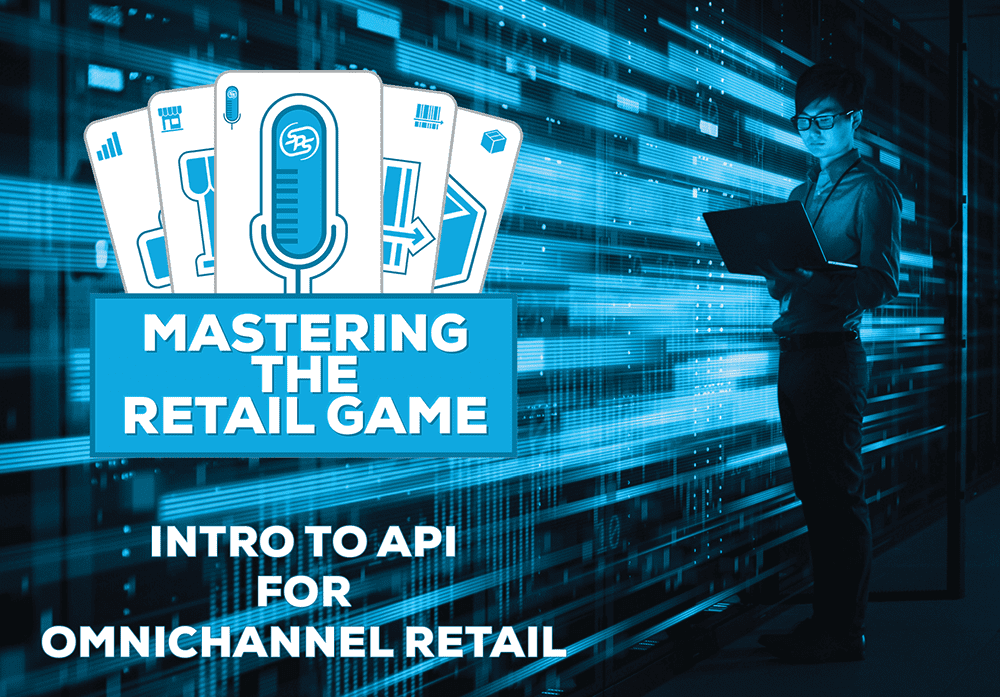Intro to API for Omnichannel Retail
Podcast: Play in new window | Download
Subscribe: RSS
Synopsis:
Omnichannel sales and strategy are driving the adoption of APIs in retail. This mode of data transfer has its advantages and is particularly well-suited to the industry.
Explore why retail companies are starting to use APIs for their drop shipping and logistics communications, and how it can complement your EDI operations.
On this episode:

Bonnie Keyworth, Senior Solutions Strategist, SPS Commerce
With over twenty years in the complex world of EDI, Bonnie Keyworth adds value to retailers and suppliers by designing solutions for a variety of ERPs and for any transaction required in their supply chain. As a Senior Solution Strategist with SPS, she enjoys the variety of projects and the new challenges each one presents. Working closely with customers on common goals is a top strength for her, which drives her toward success with every endeavor.

Tony Thrasher, Group Product Manager, SPS Commerce
As an expert in retail fulfillment, Tony offers a unique viewpoint on using the latest retail technologies, including the SPS Commerce Retail Network, RFID and more to drive innovation and growth. At SPS, he is responsible for using graph-based architecture to drive meaningful insights and expand the value of the SPS Commerce Platform to customers and partners.
“When you look at product content and all the different locations that we as consumers see product content. Honestly, a lot of that is powered by an API somewhere.”
Episode Transcript
Bonnie Keyworth (BK): Welcome to the Mastering the Retail Game podcast from SPS Commerce, where we explore the new rules of retail and provide real world advice on how to win by learning from your peers and industry experts.
I’m your host Bonnie Keyworth, and in this episode we’ll be talking about APIs and why e-ommerce is driving their adoption in retail. We’ll discuss why this mode of data transfer is used, and when and if you need to educate yourself on it. Without delving into API development details, we will explore why retail companies are starting to use APIs for their drop shipping and logistics communications, and how it can complement your EDI operations.
Today we’ll be talking with Tony Thrasher from SPS Commerce. He is the mastermind behind our company’s API strategy and has been working with our retail customers to vet how and when to publish APIs that matter. Hi Tony, welcome to the show.
Tony Thrasher (TT): Hi Bonnie. Thanks for having me. I’d say mastermind is a little heavy, but thank you regardless for the introduction.
BK: You bet. Okay. Glad to have you here. So before we dive into why APIs are able to address market demands for retail, can you briefly describe what an API is for our non-technical audience?
TT: Sure. So APIs are really simply, just a way to exchange data between two systems, or think of those as two computers. Right? The analogy that I use is think of two different systems as two islands. And in order to connect those two islands, you’d build a bridge. So in this case the bridge is really the API for exchanging data, performing an action, et cetera, et cetera. So that’s the way I like to think of it at a very, very high level.
BK: So I’m going to back you up one more step and even for the more nontechnical, what does API stand for?
TT: Application Programming Interface.
BK: And that’s something we can pretty much forget, right? Because …
TT: Yeah, you don’t have to know about that at all.
BK: Okay. Because, I’ve been in IT for years and years, and I don’t know how long it was before I finally found out what API was.
TT: Yeah Acronyms are fun.
BK: Okay. Why is API such a trend in retail right now?
TT: You know, I really think, Bonnie, it started with eCommerce, omnichannel, that explosion, whatever word you want to use to describe that. And really it comes with the pressure that the consumer has been putting on any merchant that wants to find products in many different channels, have the right product content, how do I get a personalized shopping experience, et cetera, et cetera.
And the industry has really embraced API as a solve for some of those experiences. So you look at APIs in personalization, like I mentioned, how many likes of this product do I have on Facebook, inventory levels, product content, shipping, et cetera.
So APIs are really exploding in retail because of the fact that you have this end consumer that wants to interact with and have a cohesive experience across all these different channels. So these retailers and different folks that are in the retail space are looking at ways of exposing this data, exposing it to developer communities to build innovative ways of selling and just getting more orders and getting items and goods to end consumers in a more streamlined way.
And when you look at some of the stats, and I was refreshing myself before I came up here, but if you look at programmable web, in 2013 they had something like 115 retailer, quote unquote APIs, that they would say were out there. And I just checked before I came up here, and it’s up to over 22,000 in 2019, so it’s exploding. You seen that explosion, the economy of API’s, et cetera, et cetera in other industries. But retailer is certainly feeling it too.
BK: Incredible. That’s quite the increase. So what about drop ship orders? We’ve talked in other podcasts about the data needed to support that model, and it’s often a challenge. So could you speak to that a bit?
TT: Yeah. When you look at the drop ship scenario, kind of at brass tacks … the way I’m defining drop ship in this instance is when we have a supplier or vendor that’s shipping on behalf of a retailer. So that retailer wants it to look like the goods came from them at the point in time which it gets delivered to any of our doorsteps, for example. You look at the way that previously the retailer would have all the information necessary to close that sale. Well now they have to be able to share things like inventory information. The order that needs to go out to that supplier to get fulfilled is extremely quick. It’s no longer ship this giant truckload of things to my DC. They need something that can be acknowledged very quickly. Yes, I can fulfill this to your end customer and get it to their doorstep.
So you look at the product content, the inventory, and then the ordering process, and all of those processes have sped up incredibly with this new business model. And that’s where we’re seeing a lot of retailers tipping towards API to satisfy some of those requirements.
BK: So APIs, are they also being used to facilitate logistics with retail?
TT: Yeah, we see a lot of API and have a lot of conversations regarding APIs with our logistics partners. And you look at what these companies are up against. Take 3PL, for example, working on behalf of a supplier, and they are taking orders and shipping orders through all these different channels, marketplace, eCommerce, retail, and certainly you look at marketplace and eCommerce, those are typically API-based systems that they’re interacting with. So these logistics companies become very accustomed to interacting with an API and they want to do that for those retail orders as well.
And then you look at a carrier situation where they might be getting asked to, “Hey come pick up this load,” or, “Hey can you come pick this up, can you go deliver this? Can I print my labels for UPS via an API call?” All those types of things. You see a lot of carrier consolidator plays out there, companies that are pulling that together, extending it to rate shopping, et cetera, et cetera. So logistics companies, big time.
And we’ve started to partner with our logistics customers and partners in a lot of ways regarding some of the APIs that that SPS offers as well. And they’ve been very interested.
BK: So in addition to order volumes, what about, I imagine, adding items or SKUs daily? That’s something that’s involved as well?
TT: Yeah. When you look at product content and all the different locations that we as consumers see product content. Honestly, a lot of that is powered by an API somewhere, that has that information or inventory. Like, how do you know that when you’re shopping on Facebook that the inventory is X? And then when you’re shopping on this eCommerce store, it’s X and et cetera, et cetera. It’s because that information is being shared across the web by different parties of the supply chain.
BK: Right. Well, I suppose it’s a great fit for your Walmart and Wayfair where they want to get their items up and loaded right away for the shopping carts and such. So, are APIs a good fit for retail communications like Walmart and Wayfair? Is that always true?
TT: Yeah. Well, we’re seeing a lot of retailers taking a fresh look at how they’re collaborating with their suppliers and their supplier community. So they’re going to look at the way that they collaborate on item information, inventory, information orders, shipments, and all these different business models. And they’re going to look for opportunities to improve.
So we’re seeing Walmart, for example, publishing APIs around product content. Walmart also has a bunch of APIs that are out there around product reviews and different things of that nature to support their marketplace.
Wayfair actually just rolled out a program to their supplier community, specifically 100% API as a means of them getting up to speed and really they’re looking at as “I want to collaborate, I want folks to be able to extend my reach,” and API is an option for them to do that.”
BK: So, whether a retailer uses an API or EDI or other format, what factors should a retailer consider?
TT: Yeah, you get into this age old API versus EDI, and when’s EDI going to go extinct, because API is going to take over the world. Like that whole banter, Google it, have yourself a thrilling hour.
But at the end of the day there’s pluses to doing EDI. There’s pluses to doing API. EDI comes with a standard format. It’s been around for a long time. You know when you’re getting a purchase order, what it’s going to look and feel like. There’s some built in security pieces there that you don’t have to be quite as intentional about, as you do as with the EDI landscape.
But API is also faster to implement. We’re talking typically days versus months. It’s something that you can get implemented very quickly without having to set up mail bags and do some additional configuration that happens with EDI. It’s also really good at that real time communication. So when you’re talking about transactions like inventory or things of that nature that need to be communicated instantaneously, API, we’re seeing people definitely lean in that direction.
So, at the end of the day you’re looking at a business process that typically, at least in our world, centers on the collaboration between a retailer and downstream parties of the supply chain, and the technology that you’re using is the technology. And sometimes one might work better than the other, but at the end of the day it’s focusing on that business process that’s the most important.
BK: So SPS is typically known for EDI and cloud-based solutions. How does SPS support APIs?
TT: So yeah, we’ve been working with APIs both internally for how we build our products and our services and deliver on those commitments. And then also externally, we connect to several system APIs. We connect to retailers via an API. We’re publishing APIs of our own via our development website for folks to be able to connect with and interact with our network through API.
So again, there’s obvious advantages to API. There’s some advantages to EDI, and we really promote the thought that these two technologies are going to continue to work together on it, and obviously a big investment for what SPS Commerce has done, been very successful at, and will continue to be successful at, is our ability to collaborate with the retailer and that doesn’t matter whether you’re doing EDI, API, or blockchain or whatever the heck comes next.
BK: All right. Wow, that’s great. And I love your using the word collaboration, because it really sounds like the business activity is what should dictate what’s needed, not just what the latest tech fad is. Right, Tony?
TT: For sure. For sure.
BK: All right. Healthy collaboration is the way. Great to know retailers have options, Tony. Thanks so much for sharing your knowledge of API with us today. Quite informative.
TT: Thanks for having me.
BK: And thanks to you, the listener, for choosing this episode of Mastering the Retail Game. You can read transcripts of this podcast, review show notes, and listen to other episodes by visiting SPSCommerce.com/podcast, or by subscribing on your podcast player.
Join us on the next episode of Mastering the Retail Game for more advice on what you need to know to win over today’s consumers. Until then, this is Bonnie Keyworth from SPS Commerce wishing you a rewarding journey in the ethereal world of EDI and cloud-based solutions.

Mastering the Retail Game
Explore the new rules of retail and get real-world advice on how to win by learning from retail experts and peers in the industry.
LISTEN TO THE PODCAST- Sync up for success: tips to tackle peak season - July 2, 2024
- How to become an omnichannel 3PL company - June 26, 2024
- Five considerations for Microsoft Dynamics 365 EDI - June 19, 2024





RELATED POSTS
Managing Returns Post-Holiday and All...
Intro to API for Omnichannel Retail
Bringing Your Vendors Along with Changes